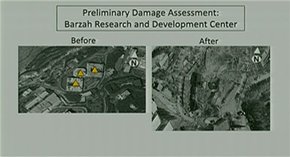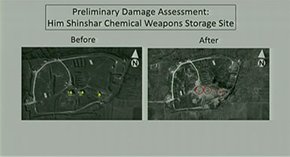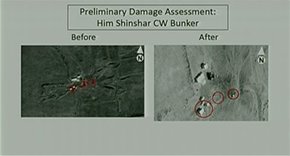Updates.
Russia claims 103 missiles were launched with 71 of them shot down including all 12 aimed at Dumair airbase. and 3 Storm Shadow missiles over Homs province. From the US side, destroyers USS Porter, USS Donald Cook and USS Higgins participated, the Brits used 4 Tornados, the French used frigates, Rafales, and Mirages. The official line out of Syria and Russia is that no serious damage was done, and the overwhelming majority of missiles aimed at functioning military facilities was shot down. They also claim that some old chemical weapons facilities that were targeted had been empty for a long time with no personnel or equipment.
https://colonelcassad.livejournal.com/4119740.html
Заявление ВС САР: Большинство ракет выпущенных американо-британо-французским агрессором сбито
Появились первые кадры с "разбомбленного" аэродрома Меззе
Брифинг в Минобороны России о результатах удара США, Франции и Великобритании по Сирии
Russia says that they have no evidence that France participated in the strike and that it was France that warned Russia of the strike. Additionally, Russia did no participate in shooting down any missiles. Also, in a contradictory statement, US Ambassador to Russia claims that the US did warn Russia of the strike.
Минобороны: по Сирии выпущено более 100 ракет, Франция предупредила Россию об ударе
http://classic.newsru.com/russia/14apr2018/norafal.html
http://classic.newsru.com/russia/14apr2018/jonsays.html
In the aftermath of the strikes it comes out that apparently the Pentagon was suggesting softer options on Syria, and Trump rejected them.
http://classic.newsru.com/world/14apr2018/makempay.html
US official statement on the strikes.
https://www.defense.gov/News/News-R...atement-by-secretary-james-n-mattis-on-syria/
The US disagrees with Russian claims that the attack in Duma was staged by Britain. France has meanwhile declassified a report on the chemical attacks in Duma and the contents of the report positively claim that the attack did take place and that Assad was most likely responsible.
http://classic.newsru.com/world/13apr2018/sarahsanders.html
http://classic.newsru.com/world/14apr2018/frdouma.html
Russia claims 103 missiles were launched with 71 of them shot down including all 12 aimed at Dumair airbase. and 3 Storm Shadow missiles over Homs province. From the US side, destroyers USS Porter, USS Donald Cook and USS Higgins participated, the Brits used 4 Tornados, the French used frigates, Rafales, and Mirages. The official line out of Syria and Russia is that no serious damage was done, and the overwhelming majority of missiles aimed at functioning military facilities was shot down. They also claim that some old chemical weapons facilities that were targeted had been empty for a long time with no personnel or equipment.
https://colonelcassad.livejournal.com/4119740.html
Заявление ВС САР: Большинство ракет выпущенных американо-британо-французским агрессором сбито
Появились первые кадры с "разбомбленного" аэродрома Меззе
Брифинг в Минобороны России о результатах удара США, Франции и Великобритании по Сирии
Russia says that they have no evidence that France participated in the strike and that it was France that warned Russia of the strike. Additionally, Russia did no participate in shooting down any missiles. Also, in a contradictory statement, US Ambassador to Russia claims that the US did warn Russia of the strike.
Минобороны: по Сирии выпущено более 100 ракет, Франция предупредила Россию об ударе
http://classic.newsru.com/russia/14apr2018/norafal.html
http://classic.newsru.com/russia/14apr2018/jonsays.html
In the aftermath of the strikes it comes out that apparently the Pentagon was suggesting softer options on Syria, and Trump rejected them.
http://classic.newsru.com/world/14apr2018/makempay.html
US official statement on the strikes.
https://www.defense.gov/News/News-R...atement-by-secretary-james-n-mattis-on-syria/
The US disagrees with Russian claims that the attack in Duma was staged by Britain. France has meanwhile declassified a report on the chemical attacks in Duma and the contents of the report positively claim that the attack did take place and that Assad was most likely responsible.
http://classic.newsru.com/world/13apr2018/sarahsanders.html
http://classic.newsru.com/world/14apr2018/frdouma.html



